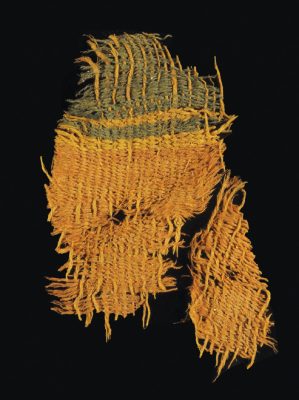×


We have detected your country as:
Please click here to go to the USA website or select another country from the dropdown list.
 Excavations conducted since 2013 in the Timna Valley have recovered dozens of fragments of 3,000-year-old textiles, preserved thanks to the region’s extreme arid climatic conditions. The textiles date to the early Iron Age (12th–10th centuries BC), the time of the biblical kings David and Solomon. Some pieces are decorated with a red-and-blue band pattern.
Excavations conducted since 2013 in the Timna Valley have recovered dozens of fragments of 3,000-year-old textiles, preserved thanks to the region’s extreme arid climatic conditions. The textiles date to the early Iron Age (12th–10th centuries BC), the time of the biblical kings David and Solomon. Some pieces are decorated with a red-and-blue band pattern.
These are the earliest examples of plant-based dyes in the Levant (the eastern Mediterranean). The dyes were identified at the Bar-Ilan University laboratories and on analysis, indicated the use of two main plants: madder, whose roots provided a red dye, and indigotin—probably produced from woad. Both these plants are among the best-known plant dyes in the ancient world. Once grown specifically for dyeing in Eretz Israel, their use continued up to the discovery of synthetic colors. The textiles from Timna were colored with true dye, which is characterized by a chemical bond between dye and fiber, attesting to professional knowledge and skill in the art of dyeing during this period.
The colored woolen textiles came as a surprise to the researchers since, during the Iron Age, Timna was principally an important smelting and mining site for copper. According to excavation director, Dr. Erez Ben-Yosef of Tel Aviv University and Dr. Naama Sukenik of the IAA, “The findings indicate that the society at Timna, identified with the Kingdom of Edom, was hierarchical and included an upper class that had access to colorful, prestigious textiles.” The context in which the textiles were found suggests that the metalworkers responsible for operating the smelting furnaces apparently enjoyed high social status and wore distinctive, colored garments. The findings contradict the previous research supposition that the furnaces in the heart of the desert were operated by slaves.
Source: Excerpts from an article by Edgar Asher, Ashernet
Photo Credit: Ashernet
All logos and trademarks in this site are property of their respective owner. All other materials are property of Bridges for Peace. Copyright © 2024.
Website Site Design by J-Town Internet Services Ltd. - Based in Jerusalem and Serving the World.